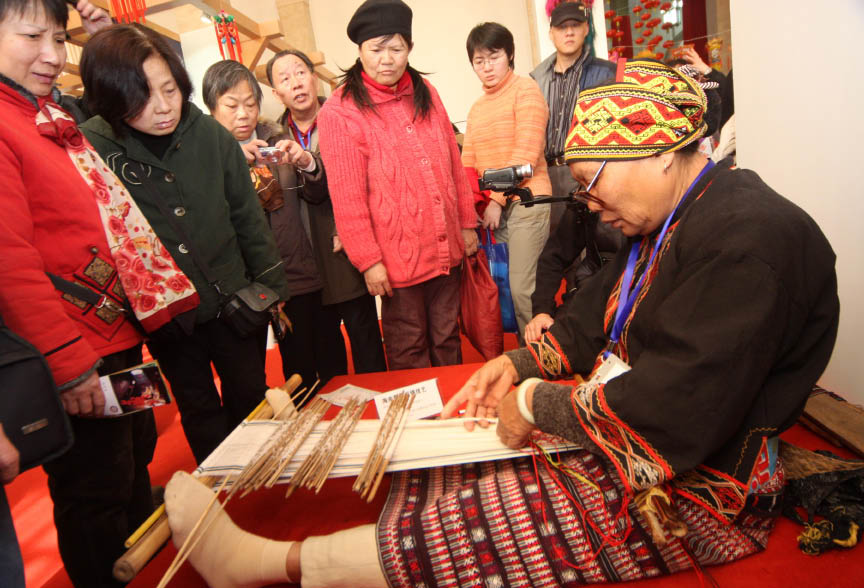Rong Yamei: Weaver and Warden of Li Brocade
By staff reporter JIAO FENG
THE women of Yongyi Village gather most days under a century-old banyan tree to weave Li brocade on crude looms that resemble little more than stacks of wood. The fabric that takes shape over this contraption, however, is dazzlingly splendid.
This reclusive rural community is part of Qianjia Town, Ledong Li Autonomous County, Hainan Province. The Ministry of Culture has chosen it to host a pilot program to preserve the time-honored Li techniques of cotton textile production. Rong Yamei, a native of Yongyi, is a master of the craft. After Li Brocade weaving was acknowledged as national intangible cultural heritage, Rong, 58, was nominated as official custodian of this venerable craft.
 |
| Visitors watch as Rong Yamei weaves Li Brocade. |
Living Fossil of Textile Industry
Dating back over 3,000 years, Li Brocade is believed to have been the earliest cotton textile produced in China, making its birthplace Hainan Province the cradle of China’s cotton textile industry. In the mid-13th century Huang Daopo, a migrant from Shanghai, brought the techniques developed by the local Li ethnic group to inland regions, introducing her own innovations to spinning and weaving tools. This took China’s cotton textile industry to new heights.
“Li Brocade is part of our identity, and a feature of clothes worn at major events of our lives,” said Rong Yamei. The fabric can be seen in traditional dress including barrel skirts, upper garments, kerchiefs, caps, ribbons, as well as quilt covers and ornaments. As the Li ethnic minority doesn’t have its own written language, part of its history and cultural legacy are handed down from generation to generation through the brocade. Some refer to it as the “oracle bone script” of the Li people. In 2009 the Li Brocade weaving was put on the UNESCO List of Intangible Cultural Heritage in Need of Urgent Safeguarding.
When China Today visited Rong Yamei, the one-meter-high shrubs that surround her house were festooned with pink and yellow blossoms. These shrubs are known locally as jibei, a breed of Gossypium barbadense, or sea island cotton, which produces the fibers used to make Li Brocade. The plant is one of the oldest cotton varieties in China. After millennia of use by the Li people it has become a synonym for Li Brocade.
Though she could easily buy yarn from the market, Rong insists on growing the cotton herself. “What I am doing is to preserve the whole process of Li Brocade production, from A to Z. And it starts with the raw material – jibei,” she explained. “The finished yarns available in the market may be of better quality, with a greater variety of colors, but these merits cannot make up for the loss of the originality that comes with the traditionally used material.
With these fibers Rong makes her own yarns using an ancient spinning technique that appears primitive in this age of industrialization and automation. The tool has a minimalist design – a simple wooden stick that serves as a spindle. After winding a tuft of ginned cotton around it, Rong presses her hands flat against the wood and rolls it rapidly on her lap before suddenly twisting it into the air. After several flips the material is shaped into cotton roving. The process is repeated, and the spindle grows increasingly plump.
According to Rong, the procedure is much more demanding than it looks. Only after long practice can one produce yarns of even thickness and a good consistency. “That’s why using a pedaled spinning wheel is favored over this method, which is close to extinction,” Rong said.
Like her Li ancestors, Rong resorts to natural sources for pigments to dye her fabric. The red comes from a native arbor species called Pan, yellow from wild ginger, and black from the leaves of two local plants known as Boufai and Bouwen. This trio makes up the classic colors of Li Brocade.
A Token of Love
Like many Li women, Rong Yamei owes her marriage to the craft she has inherited and practices. Chubby and swarthy in her youth, Rong lacked confidence in her looks. So when she developed a crush on fellow villager Ji Yalao, she hid her feelings. But in reality the bashful lad also admired the girl in secret but hadn’t the courage to approach her. Upon discovering this, Rong decided to break the impasse by presenting him with a brocade gift she had made herself.
Not wishing her parents to find out, Rong wove this gift in secret, staying up at night and working by the light of the moon or under a dim oil lamp. It took her two full months to finish the fabric and sew it into a bag embellished with a pattern featuring a man’s silhouette. When presented to Ji Yalao, the young man understood the meaning woven into it. The couple got married when Rong was 23, and they now have three daughters and a son.
Ji is a practical man, adept at carpentry and basketry. “He repairs and makes the tools needed for spinning and weaving, and supports me in teaching the craft to our daughters and other girls in the village so that our heritage can be passed down,” his wife said proudly.
From Mother to Daughter
Like all other arts and crafts, what distinguishes a master from a mediocre practitioner is creativity. The soul of Li Brocade lies in its design, which features wildlife and other objects and activities seen in everyday local life. Without a written language, the swatches themselves serve as de facto textbooks for novices and are indispensable alongside the tutorship of their mothers. Each generation contributes to the archive of brocade patterns, creating new ones or reinventing existing ones.
These patterns and the skills to make them are passed down from mother to daughter. According to Li customs, only women learn how to make Li Brocade. Rong’s mother was among the best brocade weavers in the town and began coaching her in the craft when she was eight. Learning side by side with her mother, Rong could independently produce a piece of brocade of decent quality from the age of 13.
“Every Li woman inherits from her mother swatches of different designs, and will someday hand them to her daughters,” Rong said. “Beginners in brocade making are expected to just copy exactly how each weft and warp is aligned in these inherited patterns. When they get more skilled, they can create their own versions with personal adaptations. But the influence of their mothers remains a defining factor in a Li woman’s individual style.”
Items made of Li Brocade are essential for women’s dowries, of which the centerpiece is the wedding gown. In most families the dress is made by the bride’s mother, but Rong Yamei made her own. One of four girls in her family, she volunteered to lighten her mother’s sartorial burden, who had full confidence in Yamei’s workmanship.
Rong’s three daughters have learnt how to make Li Brocade from her, and the best student has turned out to be Ji Shaoqiang, who came to the trade relatively late in life. She didn’t try her hand at the old art until in her 20s. “Li Brocade was the sole fabric used for clothing in my mother’s generation,” she explained. “But in my generation we have more choice. The process is complicated and exact, which inhibits most young girls from learning it.”
Traditional Li dress itself is fading from daily use among the ethnic group. Except on traditional holidays, most people other than the elderly clad themselves in modern, mass-produced clothes. The Li women’s signature barrel skirt, which often features the most splendid Li Brocade creations, is no longer in daily use.
Facing this environment, the work of Rong Yamei and her daughters is critical for the continuity of an ethnic art that is part of the group’s identity and legacy. In June 2006 Yong Yamei and Ji Shao-qiang participated in the first Li Brocade Competition of Hainan Province, the first time they brought their works outside of their hamlet, and won the top prize. The event exposed them to the attention of researchers, artists and collectors around the world, and palpably boosted the ancient art’s reputation.
Knowledge of the art was further spread at the 2012 Yeosu World Expo in South Korea, when Rong Yamei staged an on-site demonstration of the spinning and weaving process in front of a large assembly of international visitors.
Yet this unassuming farm wife isn’t seeking worldwide fame; her self-imposed mission is humbler. “The brocade is part of the Li culture,” she said, “and we must ensure it continues to exist through the ages.” As her loom continues to clack back and forth every day and more youngsters approach her in search of apprenticeships, people have good reason to believe that her efforts will not be in vain.

